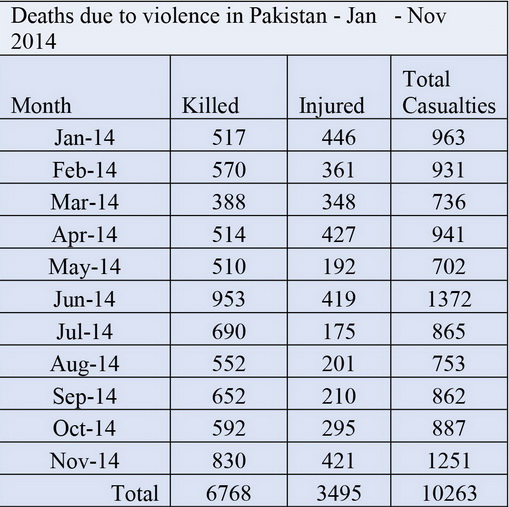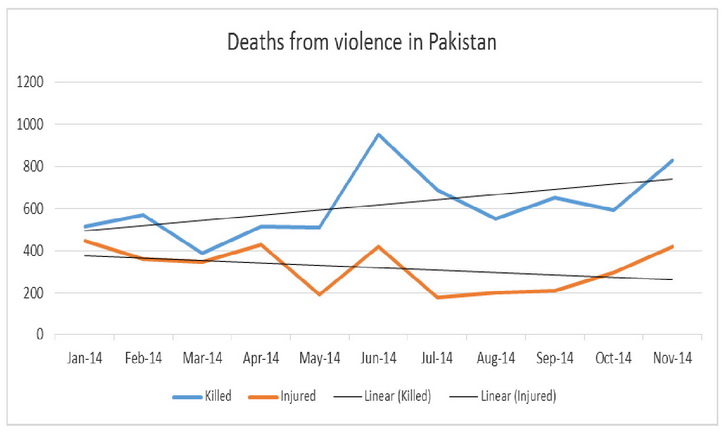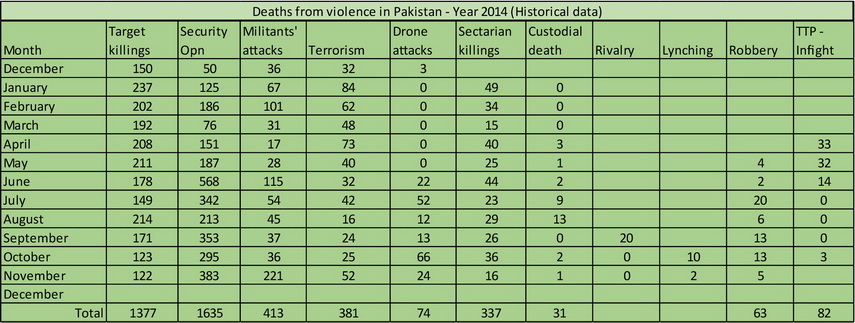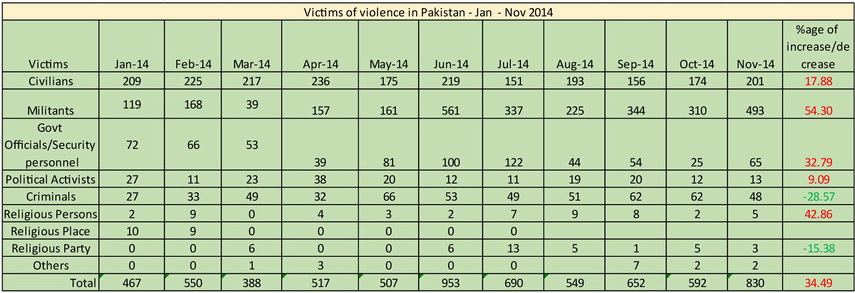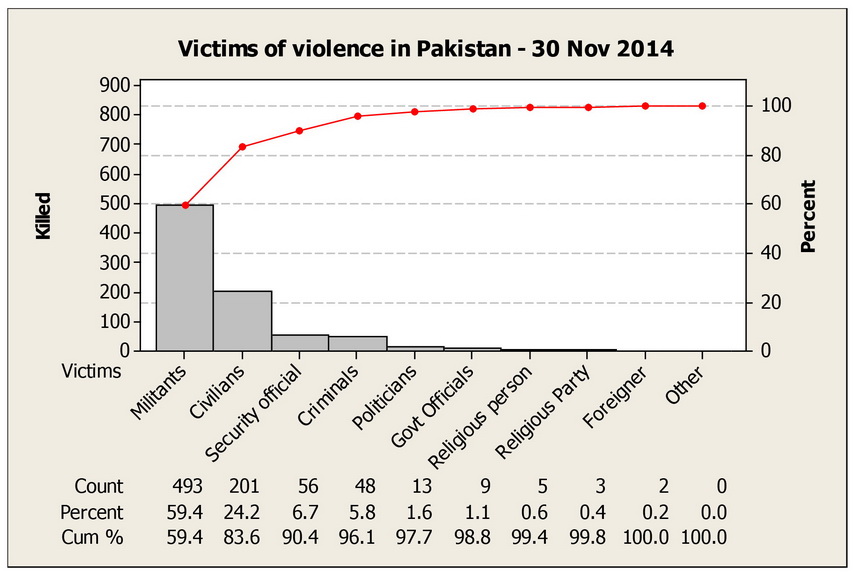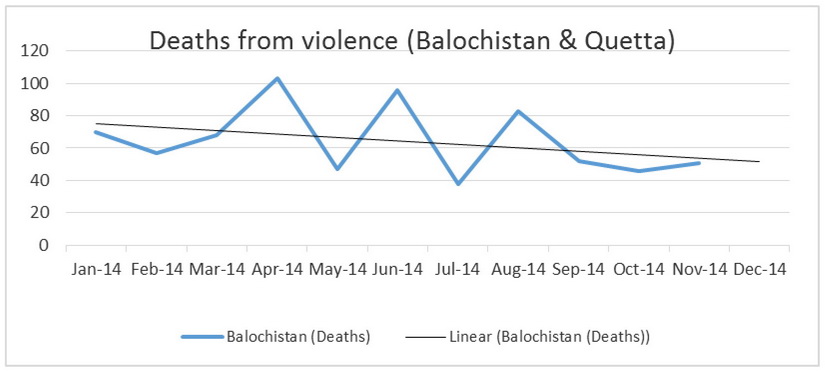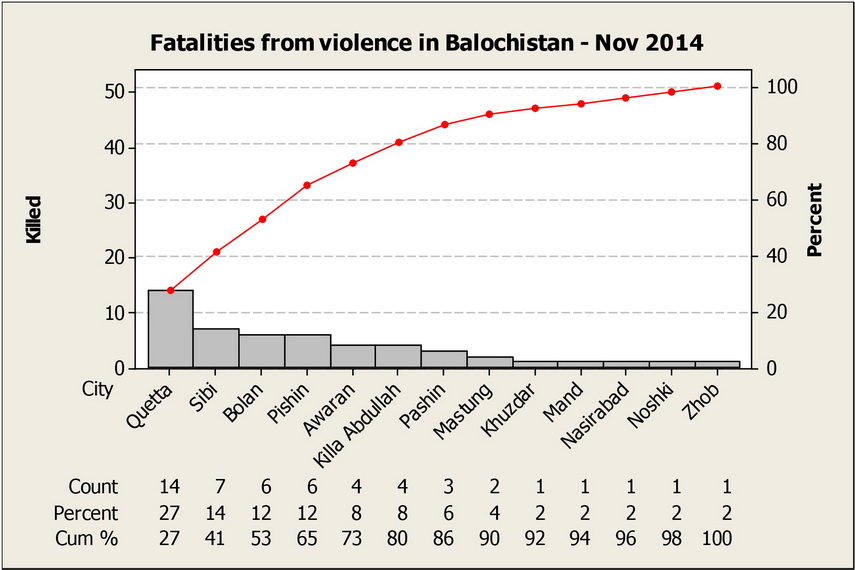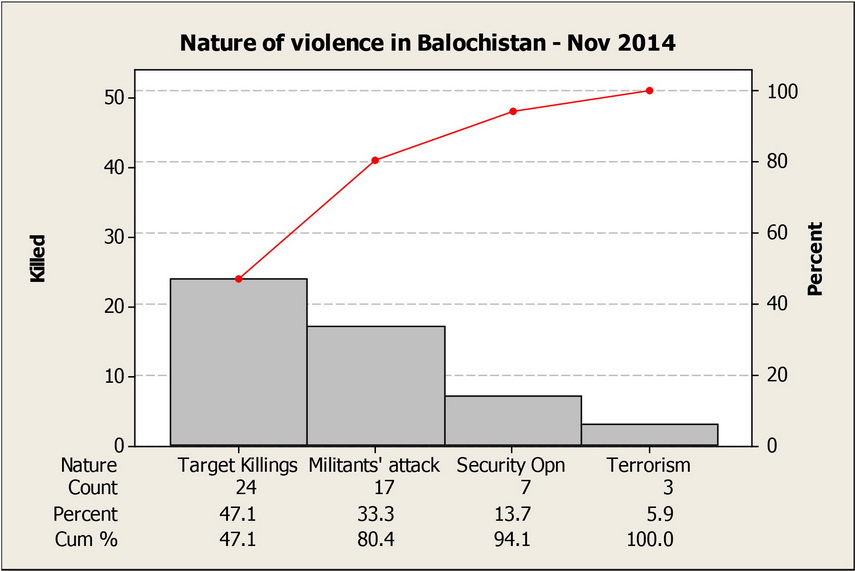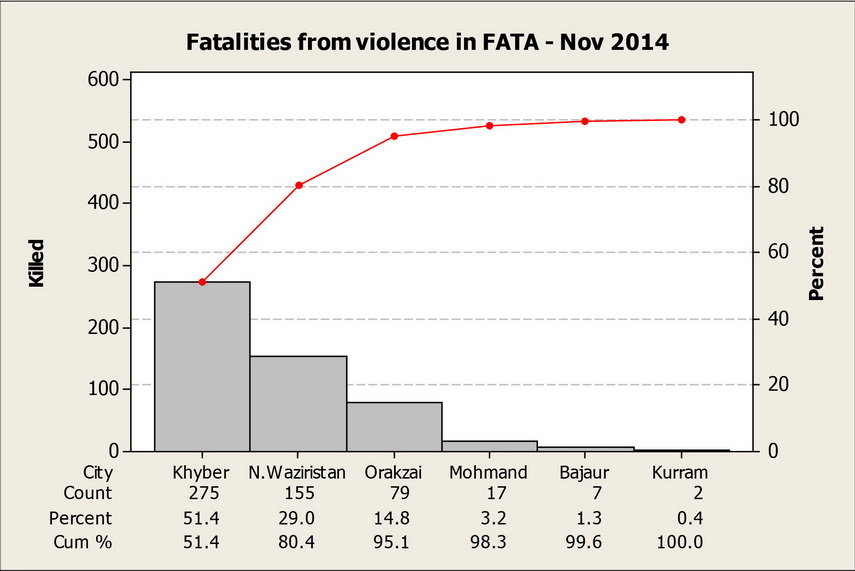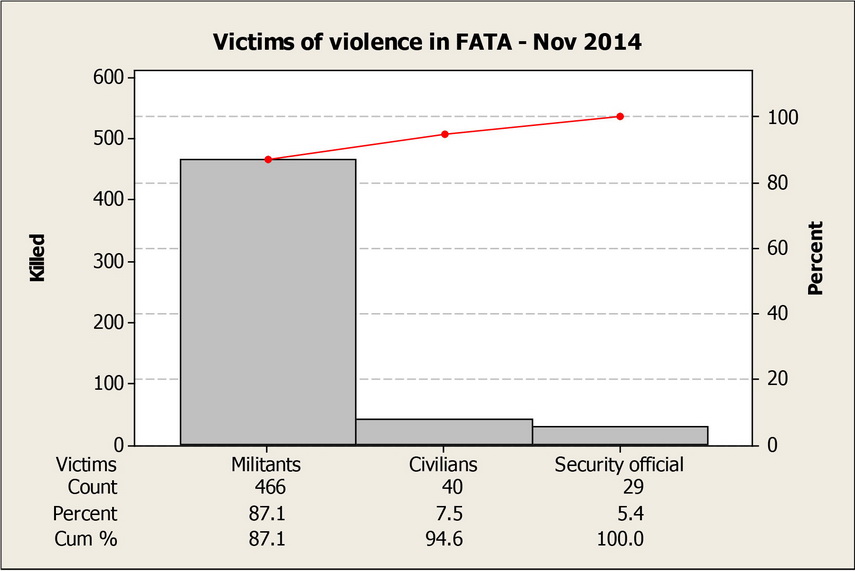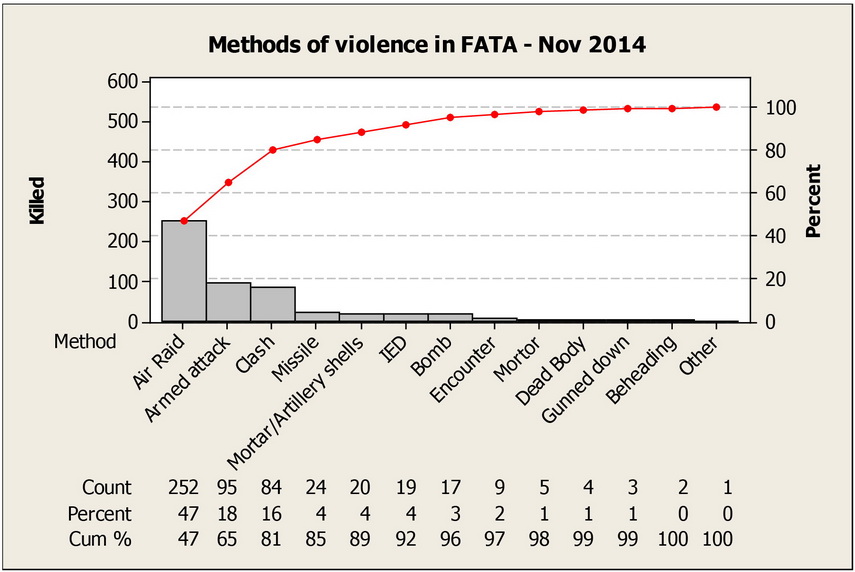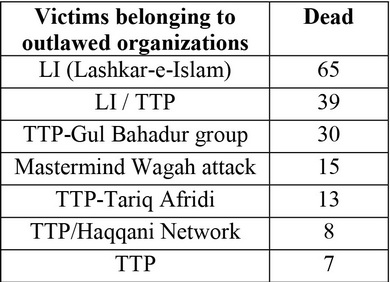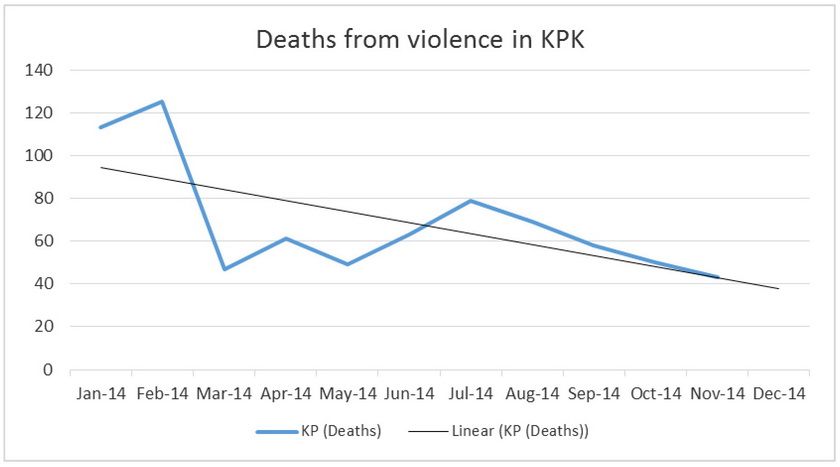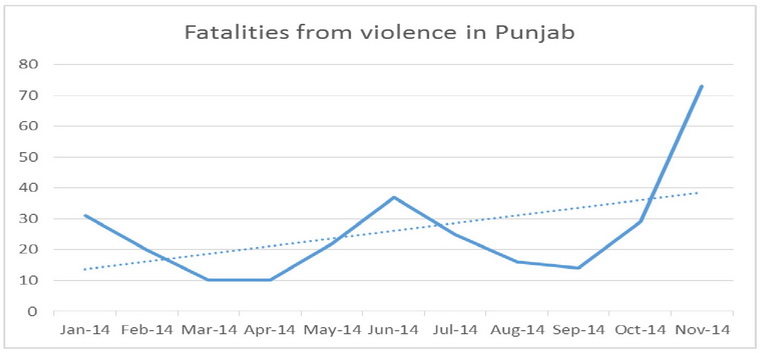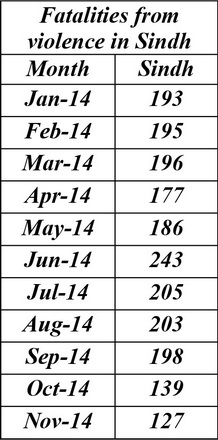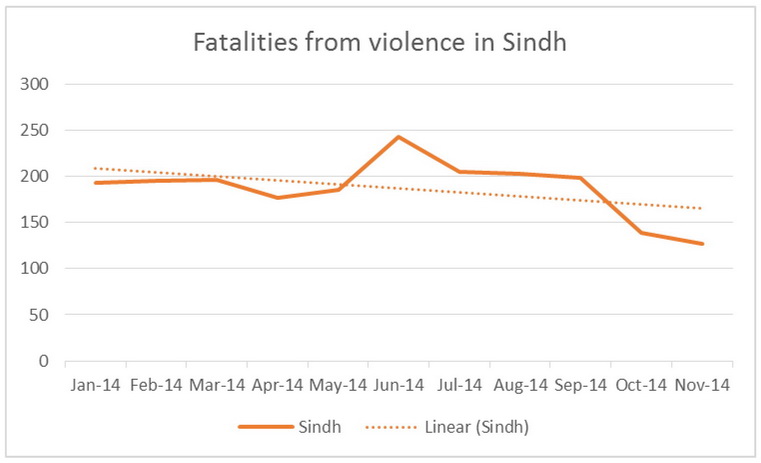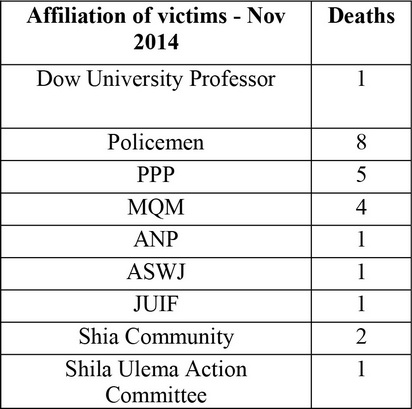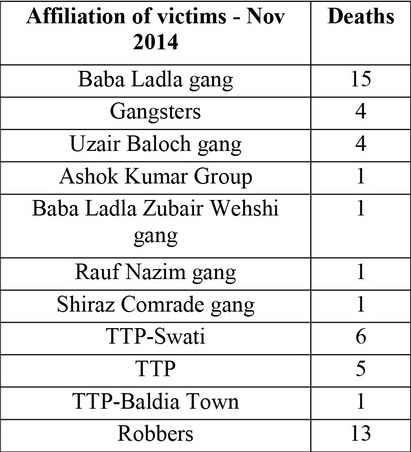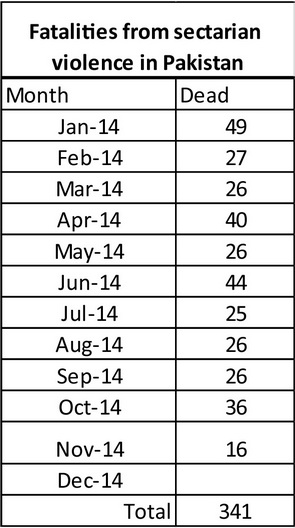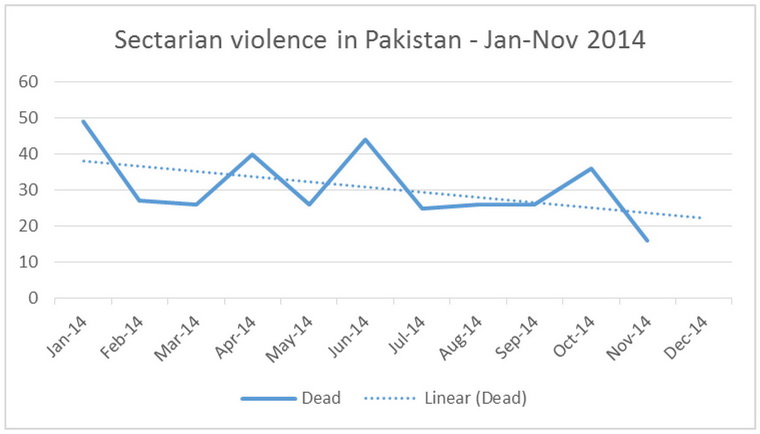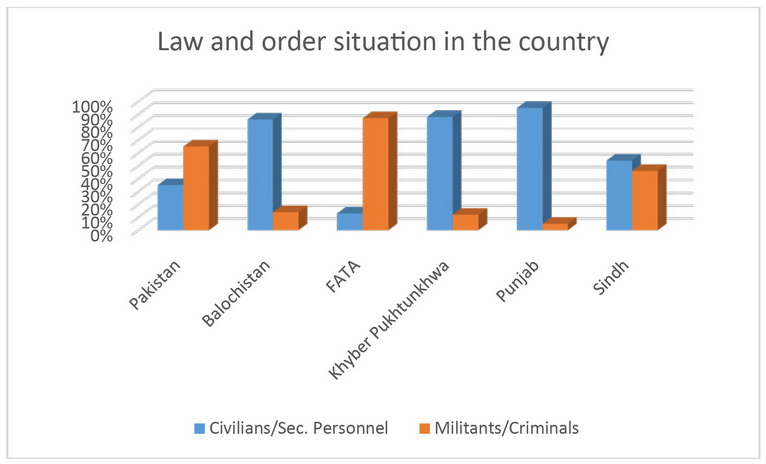This month, the provincial governments of Balochistan and Khyber Pukhtunkhwa came under attack for failing to improve the security situation in their provinces[1] [2]. The province of Sindh was not spared either when the opposition parties came out lashing at the government for the deteriorating law and order situation from Karachi to Kashmore[3].Parliamentarians flagging these issues is a good sign but it warrants an objective evaluation of their observations.
Taking a lead from these voices of concerns, this report is going to make an attempt to analyze the overall law and order situation in the country and see if the observations of the parliamentarians were close to the ground realities. The following topics are selected to have a comprehensive coverage of the subject being discussed:
Casualties of violence in the country during November 2014
Casualties of violence in Balochistan
Casualties of violence in FATA
Casualties of violence in Khyber Pakhtunkhwa (KP)
Casualties of violence in Punjab
Casualties of violence in Sindh
Sectarian violence in Pakistan
This report is compiled from open sources of information, largely reports as they appear in national newspapers including The News, Express Tribune, Dawn, Daily Times, and the Frontier Post, during the month of October. All efforts are taken to make this report as informative and factual as possible. Errors and omissions are always a possibility in such statistical work. However, such mistakes do not substantially affect the basic objectives and the ultimate analysis of this report.
CRSS will appreciate receiving comments that the readers may have on this report.
Report prepared by:
Mohammad Nafees
Senior Research Fellow
Center for Research and Security Studies
NOTE: Readers can approach CRSS for the source of any information included in the report. Please send your request to: ( mohammad.nafees@yahoo.com or mail@crss.pk)
OVERVIEW
Fatalities from violence in the country during November 2014:
Deaths = 830
Injuries = 421
The fatalities from violence in the country rose sharply during November with 830 persons dead and 421 wounded (please see table 1, graph 1). The major cause of this surge was the ongoing military operation in Federally Administered Tribal Areas (FATA) region and the retaliatory attacks by militants in different parts of the country. The militants carried out 38 attacks during the month leaving 221 persons dead and 183 injured while the military and other security operations in the country left 383 militants dead and 45 injured. This was the largest number of casualties caused by militants in any month this year (please see table 2), thus raising the percentage of victims of violence (please see table 3). However, the majority of victims were militants and criminals (65%) while the remaining victims were civilians, security personnel, and others (please see graph 2).
Table 1: Casualties of violence in Pakistan – Nov 2014:
Graph 1: Fatalities from violence in Pakistan – Nov 2014:
Table 2: Fatalities from violence in Pakistan – Nov 2014:
Table 3: Victims of violence in Pakistan – Nov 2014:
Graph 2: Victims of violence in Pakistan – Nov 2014:
Like the previous two months, FATA had again lost the highest number of people during the month of November (535), followed by Sindh (127), Punjab (73), Balochistan (51), Khyber Pukhtunkhwa (43), and Islamabad (1). At district level, Khyber and North Waziristan Agencies of FATA had more fatalities than any other districts of the country (please see graph 3).
Graph 3: Fatalities from violence in Pakistan – Nov 2014:
Casualties of violence in Balochistan
Deaths = 51
For the last three months, Balochistan has managed to keep its crime rate under control (please see table 4). The historical data for the whole year shows a declining trend in the number of fatalities from violence in the province (please see graph 4).
Table 4: Fatalities from violence in Balochistan – Jan-Nov 2014:
Graph 4: Fatalities from violence in Balochistan – Jan-Nov 2014:
Victims of violence in November 2014 in Balochistan were primarily civilians and government officials (80%). Two incidents especially stand out in terms of scale and tragedy. One was the militants’ attack on Polio workers on 26 November 2014 that left four persons dead including three women. The second incident was the target killing of five laborers on ethnic grounds. Twelve out of thirty two districts of Balochistan were affected by violence. Quetta, Pishin, Sibi, Bolan, Awaran, and Killa Abdullah were the most affected districts (please see graph 5).
Graph 5: Fatalities from violence in Balochistan (District-level) – Jan-Nov 2014:
During this month, eleven dead bodies were discovered from two districts of Balochistan – Pishin (7) and Killa Abdullah (4). Only two were identified. Target killings, militant attacks, the security operation, and terrorism were the modes of violence that caused the bulk of deaths in the province (please see graph 6).
Graph 6: Nature of violence in Balochistan – Jan-Nov 2014:
Casualties of violence in FATA
Deaths = 535
Injuries = 132
FATA had the highest number of casualties during the month of November because of the military operation and retaliatory militancy. The districts most affected were Khyber, North Waziristan, and Orakzai agencies (please see graph 7). Among the dead, over 80% were militants and the remaining were civilians and security officials (please see graph 8). Air raids and encounters by the security forces, armed attacks, mortar shells, IED detonations, and bomb explosions by the militants, clashes between Tauheedul Islam (TI) and Lashkar-e-Islam (TI), missile fires by drones caused the bulk of casualties. These methods were used by the armed forces, militants, and NATO forces in the region leaving 535 persons dead and 132 injured (please see graph 9).
Graph 7: Fatalities from violence in FATA – Nov 2014:
Graph 8: Victims of violence in FATA – Nov 2014:
Graph 9: Methods of violence in FATA – Nov 2014:
A large number of militants belonging to different outlawed militant organizations lost their lives during November 2014 and the highest number of victims were affiliated with LI followed by other splinter groups of the Tehreek-e-Taliban of Pakistan (TTP) (please see table 5).
Table 5: Victims belonging to outlawed organizations in FATA – Nov 2014:
Among the dead were two prominent militants, Dr. Sarbaland aka Abu Khalid and his brother-in-law Major Adil Abdul Qadoos. They lost their lives in a drone attack on 21 November 2014. Major Adil was a former officer in the Pakistani Army and Dr. Sarbaland was a skillful surgeon. According to a senior Taliban commander, “Dr Sarbaland was an experienced surgeon and had set up a hospital in North Waziristan where he used to treat the al-Qaeda fighters injured in fighting against the US forces in Afghanistan. In June this year when the Pakistan Army launched military operation in North Waziristan, he shifted his clinic and his group to the Afghan border near Dattakhel where the US forces raided his compound a few days ago. Other mujahideen present there offered resistance and gave a chance to Dr. Sarbaland and his two sons, who were 13 and 14 years old, to escape,”[4]. There were two additional commanders of the TTP, Wajid Abu Bakr and his close aide Ashiqullah[5], were killed in an artillery strike in Jamrud on 30 November 2014. Their names are.
Casualties of violence in Khyber Pakhtunkhwa (KP)
Deaths = 43
Injuries = 42
Since September 2014, the fatalities from violence in Khyber Pukhtunkhwa are on the decline and in November saw the lowest casualty numbers, a sign of improving law and order situation in the province (please see table 6, graph 10).
Table 6: Fatalities from violence in Khyber Pukhtunkhwa – Nov 2014:
Graph 10: Fatalities from violence in Khyber Pukhtunkhwa – Nov 2014:
Most of the victims of violence in Khyber Pukhtunkhwa were civilians (18), security personnel (13), government officials (2), religious persons (3), and political activists (2). 10% of all victims of violence were outlawed militants. Nine out of twenty-six districts of Khyber Pukhtunkhwa witnessed fatalities from violence and Peshawar, the capital city of the province, had the highest number fatalities (16), followed by Nowshera (8), Charsadda (5), Swat (4), Bannu (3), Chitral (2), D.I. Khan (2), Tank (2), and Hangu (1). A Polio team was also attacked in Shabqadr, leaving a tenth grade student and a Polio team member injured. TTP-Jamat-ur-Ahrar claimed responsibility of this attack and issued the following statement in support of such attacks:
[“We claim responsibility for the attack on Polio workers in Shabqadr,” TTP Jamaatul Ahrar spokesperson Ehsanullah Ehsan said. “We will soon release our policy statement on Polio vaccine,” Ehsan said in a statement. “In the policy statement, we will [explain] according to Islam and science how it is dangerous to health and how it is against Islam,” he said.[6]]
Guns, bombs, hand grenades, IED’s, and mortar shells were primarily used to perpetrate violence in Khyber Pukhtunkhwa.
Casualties of violence in Punjab
Deaths = 73
Injuries = 84
Punjab suffered the heaviest casualties of violence, compared to other months. The primary cause was a suicide attack at Wagah Border during the flag hoisting ceremony (please see table 7, graph 11). Within a day, sixty people lost their lives while another 80 suffered injuries . Only four out of seventy-three victims of violence were criminals while the rest were civilians (62), security officials (4), and government officials (3).
Table 7: Fatalities from violence in Punjab – Nov 2014:
Graph 11: Fatalities from violence in Punjab – Nov 2014:
Casualties of violence in Sindh
Deaths = 127
Injuries = 105
For the past two months, the province of Sindh has witnessed a sharp decline in the number of fatalities from violence (please see table 8,graph 12).
Table 8: Fatalities from violence in Sindh – Nov 2014:
Graph 12: Fatalities from violence in Sindh – Nov 2014:
Only six out of twenty-four districts of Sindh were affected by violence in November. Karachi, the most densely populated and commercial city of the country, accounted for more than 90% of total fatalities in Sindh followed by Hyderabad (4%), Mirpurkhas (2%), and the remaining 3% from Shikarpur, Khairpur, and Sukkur. The victims of violence were almost equal for criminals (46%) including militants, target killers, robbers and gangsters, and non-criminals (54%) including civilians, security personnel, government officials, political activists, religious persons, and religious party activists. In Karachi, Lyari, Orangi, Landhi, Gulshan, Keamari, Korangi, and SITE were the areas that had the highest number of victims of violence (please see graph 13). Target killings, security forces’ operations, robberies, and terrorism were the major causes of fatalities in the province.
In Karachi, mob justice has risen as a form of counter-violence. It raises an alarming bell in the minds of security analysts indicating how anarchy is spreading and pulling common people into its ambit. During the month of November, two criminals were subjected to mob justice, another was killed in self-defence, and a fourth was killed during resistance at the time of a robbery.
Graph 13: Locations of violence in Sindh – Nov 2014:
The ongoing operation in Karachi left 46 criminals dead, 36 of whom were killed by the police while the rest of them were killed by Rangers. The affiliation of the victims of violence in Karachi varies from political activists to religious activists and outlawed militants to gangsters. Out of 127 victims of violence, 52 were identifiable as affiliated with different outlawed organizations and 24 belonged to different legal organizations and institutions (please see table 9 and 10).
Table 9: Non-criminal victims of violence in Sindh – Nov 2014:
Table 10: Criminal victims of violence in Sindh – Nov 2014:
Sectarian violence in Pakistan
Deaths = 16
Injuries = 49
Sixteen persons lost their lives and forty nine were wounded in the country in sectarian-related incidents of violence. Sindh had the highest number of victims with a loss of 8 persons and the remaining eight victims were from FATA (3), Khyber Pukhtunkhwa (3), Islamabad (1), and Punjab (1). Historical data on sectarian violence shows that it has been on the decline and November saw the lowest casualties of any month in 2014 (please see table 11, graph 14).
Table 11: Fatalities from sectarian violence in Pakistan – Jan-Nov 2014:
Graph 14: Sectarian violence in Pakistan – Jan-Nov 2014:
Majority of the victims belonged to Shia (12), Sunni (3), and Sufi (1) communities Eight out of sixteen victims of sectarian violence were civilians while seven victims were either religious leaders or associated with a religious political party. Three persons were killed in an IED explosion while the rest of them were victims of target killing.
Conclusion:
Based on this data, only Punjab experienced a sudden rise in the violence during this month while the other provinces of the country saw a decline in violence and resulting casualties. These findings are opposite to the observations of the parliamentarians but this is not the end of the story. When we look at the law and order situation from another angle we find that Balochistan, Khyber Pukhtunkhwa, and Punjab have a disproportionate percentage of fatality rate for criminals (militants, robbers, target killers, etc) and non-criminals (civilians, security personnel, political activists, religious party activists, and religious persons). In case of FATA, this percentage takes an opposite turn while in Sindh this ratio is close to each other (please see graph 15).
Graph 15: Law and order situation in Pakistan – Nov 2014:
Sindh (particularly Karachi) and FATA are two regions where ongoing security operations greatly affect casualty figures. The sudden rise in retaliatory militant attacks is a sign of how resilient the militant forces are and how quickly and effectively they can maneuver to execute a counter-strategy shows the depth of their penetration in our society. The security operation alone is not the complete answer to this problem. There are other issues associated with this challenge that need to be addressed as well, including strengthen our law enforcement agencies and eliminating extremism at the grassroots and indoctrination levels.
- http://www.thenews.com.pk/Todays-News-2-286288-Govt-under-fire-in-KP-Assembly-over-rising-acts-of-terror-extortion ↑
- http://www.thenews.com.pk/Todays-News-2-286288-Govt-under-fire-in-KP-Assembly-over-rising-acts-of-terror-extortion ↑
- http://pakobserver.net/201311/05/detailnews.asp?id=222752↑
- http://www.thenews.com.pk/Todays-News-13-34269-Al-Qaeda-members-Dr-Sarbaland-Major-Adil-killed-in-US-raid ↑
- http://tribune.com.pk/story/799574/ttp-commander-killed-in-jamrud-artillery-strikes/ ↑
- http://tribune.com.pk/story/796286/health-worker-injured-in-attack-as-charsadda-observes-polio-day/↑

